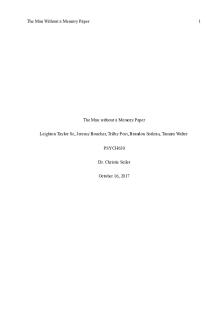Book Response Paper 3 - Summary The Man Nobody Knows PDF

| Title | Book Response Paper 3 - Summary The Man Nobody Knows |
|---|---|
| Author | Matthias Boehm |
| Course | United States History 1877 to 1977 |
| Institution | University of California, Santa Cruz |
| Pages | 2 |
| File Size | 67.7 KB |
| File Type | |
| Total Downloads | 52 |
| Total Views | 163 |
Summary
book response...
Description
Matthias Boehm TA: James Kelly
Section Letter: J
Book Response Paper Three: The Man Nobody Knows by Bruce Barton The 1920s in the United States were interpreted in two different ways. One side recognized the innovations of this time as advancements and the beginning of modern urban living. The other party only saw a rebellion against the conventional life of the past. With his book “The Man Nobody Knows” written by Bruce Barton in 2925 the author tries to contextualize this development of a modern and capitalist driven society with Jesus’ life from the bible. He attempts to realistically interpret Jesus’ parables and prove that in many aspects, Jesus was not so different than regular businessmen in the 1920s. This being said, it is clear to his readers that Barton supported the modernization of the American society. I believe that the emancipation of minorities living in America, the uprising of new technologies and leaving behind old roots marked a milestone in American history. Although many citizens tried to hold on to outworn ideas with the intention to keep immigrants inferior to the white American breed, their ideologies were outdated and rather counterproductive. In his book “The Man Nobody Knows” Barton tries to convey to his readers that the literal translation of the bible is quite unrealistic and people should let go traditional christian convictions. In his interpretation he discovers similarities between the qualities and traits of Jesus and ones of any types of leaders in the 1920s. He describes him to be a leader due to following three traits: He had communicative and behavioral skills of a leader that created a “personal magnetism which begets loyalty and commands respect (p.2).” The second trait that led to Jesus’ success was his ability to recruit qualified supporters. He looked for people that would trust and rely on, who would spread his set of beliefs and carry on his work, even after he died. These characteristics are comparable to the uprising businessmen of the 1920s. Both characters find
1
enough courage to establish a leadership role in their business. With regards to the bible, Jesus’ business idea was to spread christianity through the recruitment of “employees” whereas a businessman in modern times aims for monetary profit. Although these goals seem very different from each other, both characters are equally persuasive about organizing a group of supporters. By drawing these comparisons the author wants to justify capitalist movements during his time. The prohibition of alcohol and the radical groups such as the Ku Klux Klan opposed these upcoming ideals. Both the alcohol regulation and xenophobic driven groups were a response to modernity and the fear of an immigrant rebellion. This goes back to the first arrivals of African immigrants, when the white supremacists were worried about a possible Africanization of America. Therefore, a large group of the population during the 1920s neglected the idea of an urban city life. They were against an uprising of non governmental organizations and businesses that could gain more influence over the society than ever before. Bruce Barton explains through the figure of Jesus that there have to be new leaders that emerge as former servants from the ordinary population. Only then, “businesses” can be founded and society can better itself. Barton uses the term “eternal miracle” to describe the point in time when an individual recognizes his determination to pursue a goal. Ultimately, a modernization of America during this time was almost inevitable. Movements such as the Harlem Renaissance that brought races together acted as counter piece to the xenophobic movements. The NAACP established in 1909 also contributed to this goal of an accepting world. The modern and more secular and realistic interpretation of Jesus and his career as a businessman appealed for a multiracial and advancing society.
2...
Similar Free PDFs

The 57 Bus Response Paper
- 5 Pages

Summary of the Gingerbread man
- 1 Pages

Response Paper
- 3 Pages

Response Paper
- 3 Pages

THE Client - summary book
- 9 Pages

Summary of the book
- 151 Pages

Summary Paper- The Veldt
- 3 Pages

The Man Without A Memory Paper
- 5 Pages

Utopia Book II Summary-3
- 2 Pages

Poem Setting Response Paper
- 2 Pages

The Republic book 1 summary
- 5 Pages
Popular Institutions
- Tinajero National High School - Annex
- Politeknik Caltex Riau
- Yokohama City University
- SGT University
- University of Al-Qadisiyah
- Divine Word College of Vigan
- Techniek College Rotterdam
- Universidade de Santiago
- Universiti Teknologi MARA Cawangan Johor Kampus Pasir Gudang
- Poltekkes Kemenkes Yogyakarta
- Baguio City National High School
- Colegio san marcos
- preparatoria uno
- Centro de Bachillerato Tecnológico Industrial y de Servicios No. 107
- Dalian Maritime University
- Quang Trung Secondary School
- Colegio Tecnológico en Informática
- Corporación Regional de Educación Superior
- Grupo CEDVA
- Dar Al Uloom University
- Centro de Estudios Preuniversitarios de la Universidad Nacional de Ingeniería
- 上智大学
- Aakash International School, Nuna Majara
- San Felipe Neri Catholic School
- Kang Chiao International School - New Taipei City
- Misamis Occidental National High School
- Institución Educativa Escuela Normal Juan Ladrilleros
- Kolehiyo ng Pantukan
- Batanes State College
- Instituto Continental
- Sekolah Menengah Kejuruan Kesehatan Kaltara (Tarakan)
- Colegio de La Inmaculada Concepcion - Cebu




